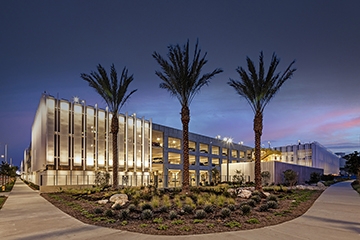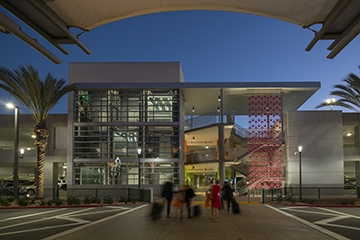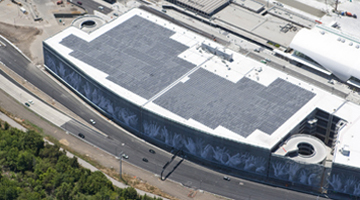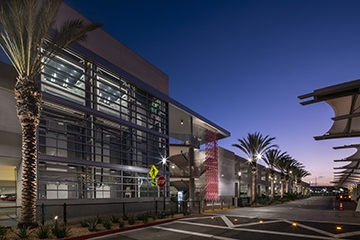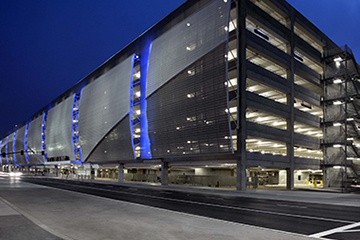Original Source: "Technology Elevates the Airport Parking Experience" by John Purinton & Michael Pendergrass for Parking Magazine
Parking Magazine: Technology Elevates the Airport Experience
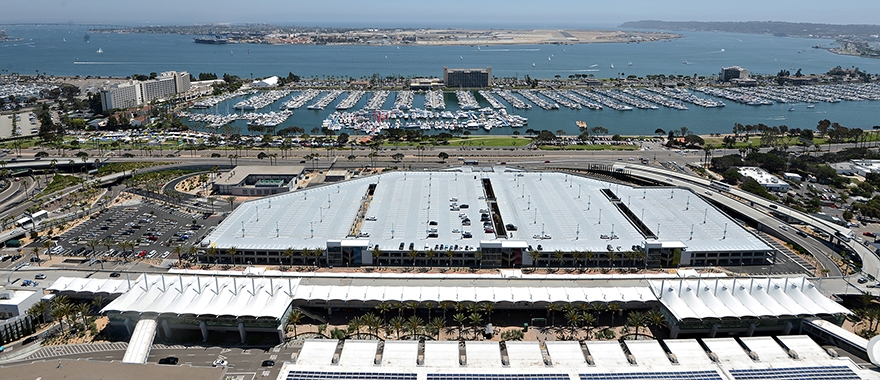
Air travel plays a significant role in many people’s lives, whether it be flying for business or for leisure trips with friends and family. Yet arriving and parking at an airport can be a significant source of stress for travelers, affecting passenger satisfaction before they ever reach the terminal. Innovative technology, such as parking guidance systems, adaptable PARCS systems, and integrated mobile apps, that provide users with real time, dynamic parking functionality can ease stress and deliver a better experience.
San Diego International Airport has integrated this state-of-the-art parking technology in its new Terminal 2 Parking Plaza to enrich the passenger experience, improve operational performance, and better manage parking inventory.
A Vision of Stress-Free Airport Parking
Crucial to their expansion plan, San Diego International Airport managers wanted to ensure a premier traveler experience. Having determined they needed to expand their parking options to meet increasing demand, they knew they did not simply want a parking garage for storing cars. Rather, they envisioned a parking plaza that would be quick and easy to use. The key to realizing that vision? Technology. With online reservations, frictionless entry and exit, and time-saving parking guidance systems, the Terminal 2 Parking Plaza was designed to be a seamless, stressfree experience.
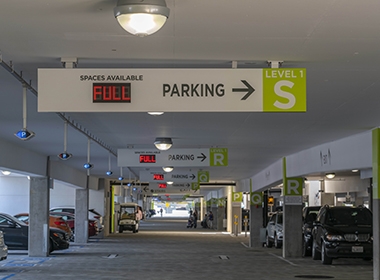
Collaborative, Coordinated Design Effort
A high-level technology experience requires a great deal of infrastructure. The extensive conduits and piping required to facilitate the various technology systems can be visible and aesthetically unappealing. However, concealing them in a facility with a building footprint of 330,000 square feet meant embedding miles of conduits into the concrete slab alongside post-tensioning and rebar.
A Partner in Technology
With such little room for error, the design-build team selected to deliver the project found it vital to partner with a technology consultant even before pursuing the RFP.“We began planning for and coordinating the technology three years before we ever put a shovel in the ground,” says Jeff Goodermote, Director of Parking Structures with Swinerton, the project’s design-builder. “Understanding how important it was to the Airport, we engaged a technology consultant on day one and gave them a voice throughout the problem solving process,” Goodermote says.
That process included a four-month coordination effort. The team sought to identify how the infrastructure for parking guidance, revenue and access control, lighting, Wi-Fi, etc. could be integrated into a 5-inch thick concrete slab.
Vendors Based on IT Needs
Another challenge that needed to be tackled early was which vendor to utilize for each system – a decision that usually takes place later in the design process. However, different vendors require different provisions for a given system, such as a physical box for every connection, versus end-of-aisle points of connection. With a facility the size and scope of the Parking Plaza, designing the infrastructure for even one set of provisions wasn’t feasible.
“You could have up to 60 conduits in the deck coming into one room,” Goodermote says. “That’s five feet of just conduits. Managing that requires additional IT rooms, which results in additional loss of parking. There are lots of decisions in play, so technology was a critical piece of the design and construction of this project that could not be brought in later – it had to be part of the initial process.”
Parking Personas
To come to a decision about which systems to select, the team had to envision exactly who they were designing the facility for. Whether someone was parking for a business trip or taking their family on vacation for spring break, the technology needed to work for them. How would they interact with it? How could it be fine-tuned to offer everyone a smooth and pleasant experience? Most importantly, how would it help expedite the process?
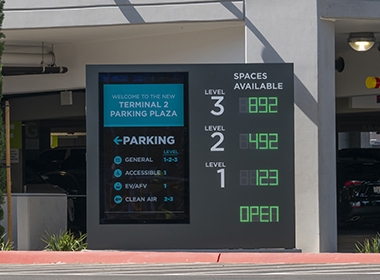
The Right First Impression
The airport’s parking needed to create a positive impression on travelers to compete with other options, like ridesharing. Because of this, the design team emphasized a combination of easy-to-use, flexible, and time saving systems. Each component, from parking access to parking guidance, integrates seamlessly to set the tone for the entire experience, starting with the first interaction.
Online Reservation Integration
For some users, that interaction begins before even leaving home with an online reservation system that allows travelers to pay for parking in advance of their arrival. The user-friendly interface was carefully designed to be simple and flexible. The system can accept discount codes and coupons, and frequent fliers can benefit from a loyalty program. To further strengthen customer engagement, the entire process is managed directly by the Airport.
“There is no third party branding, because the Airport maintains ownership of that customer journey from start to finish,” says Chris McKenty, regional adviser & senior key account manager for SKIDATA. “They wanted to be responsible for that experience.” The advance reservation system will also help the Airport manage their parking inventory more efficiently than just relying on historical data.
As travel times are not exact – plans change, planes can be delayed – a reservation does not guarantee a specific space within the plaza. However, prepaid parking does impact the parking counts reflected in dynamic signage found throughout the structure, and the technology allows for VIP reserved parking areas in the future.
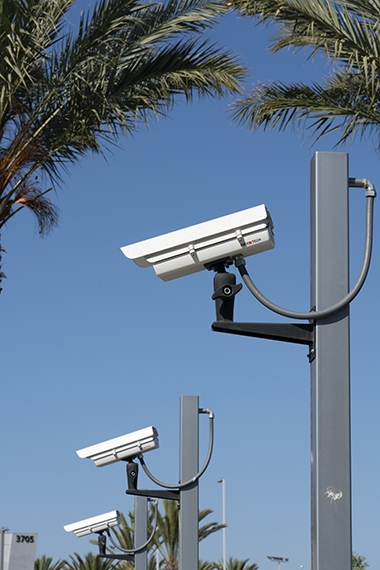
Easy In, Easy Out
Upon reaching the Airport, technology still shoulders the responsibility of that critical first impression. Therefore, entry and exit were designed to be as frictionless as possible. The parking control and access gates are equipped with license plate recognition (LPR) technology that scans both front and rear license plates. Scanning both plates accommodates cars that do not have a front plate and improves efficiency by giving the cameras two chances to get a good plate read.
Travelers who have prepaid for parking only need to scan a QR code to gain entry. In the future the system will match a license plate to a prepaid reservation and open automatically, using the QR code as a backup means of entry. Staff and contractors can access the plaza via Automatic Vehicle Identification technology. The system is also designed for future integration with California’s FasTrak toll system, which will allow users to pay via their FasTrak accounts.
The advantage of all of this flexibility is smoother, faster entry and exit, which reduces stress and helps passengers get where they need to go as quickly and efficiently as possible.
Follow the Guiding Light
Once users gain access to the parking plaza, parking guidance technology takes over to help them find a space, reducing the need for searching and circling. The system selected by the airport uses camera based sensors to detect whether or not a vehicle is occupying a parking stall. That information is conveyed to displays with real-time availability at key points throughout the structure. “Every decision point has a dynamic sign to help drivers determine whether they should go left, right or continue ahead,” says McKenty.
The first such sign can be found before even entering the facility, and informs drivers how much parking is available on each level. It also shows where travelers can find accessible, electric vehicle, and clean air vehicle spaces. If parking is more abundant on levels two and three, speed ramps allow travelers to save time by bypassing the main level entirely. Additional signage can be found on each level and in each aisle.
Signage for Safety
Beyond getting passengers parked, the parking guidance system was also carefully integrated into the functional design to improve safety. Cars are directed east to west through the Plaza, while pedestrians move south to north, in the direction of the terminal and away from vehicular traffic.
Time to Exit
Upon returning to their vehicles, travelers who have not prepaid for parking can use pay-on-foot stations to expedite exit. The LPR cameras installed at the exit will match scanned plates with whatever credential previously used to pay for parking and open automatically, without the need to stop and scan a QR code. Those who still need to pay have the option to do so upon exit.
Traveler-Focused Parking
Whether travelers make their parking plans in advance or need a simple solution upon arrival, the Terminal 2 Parking Plaza is designed to get them in, easily parked and into the terminal. Likewise, the extensive coordination that went in to preparing for such an experience is evident in what you can’t see. There are no exposed conduits or cabling in the plaza, ensuring that beyond its time-saving benefits, the interior appears open, inviting and pleasant.
The result is a parking experience that is swift, efficient, and designed around the user.

